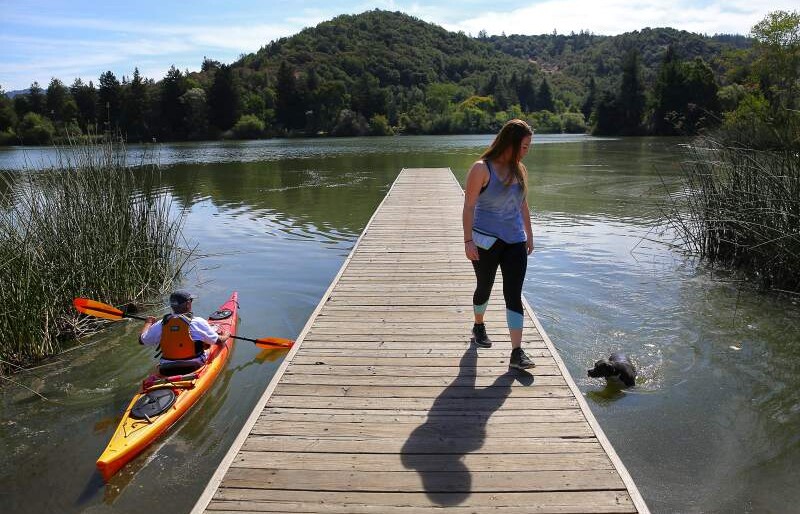by Angela Hart, The Press Democrat
A massive storm floods the upper reaches of the Russian River, destroying critical pumping infrastructure that delivers drinking water to 600,000 North Bay residents. Longer stretches of extreme heat and protracted drought conditions leave bone-dry woodlands dangerously susceptible to wildfire. Rising ocean waters threaten to infiltrate the underground aquifers farmers and rural residents depend upon.
Efforts are underway across Sonoma County to prepare for such weather extremes, which scientific models indicate are driven by climate change, according to Sonoma County officials and local experts. A new $830,000 initiative at the Sonoma County Water Agency — the first of its kind locally — seeks to develop a detailed analysis of risks and potential vulnerabilities to the county’s complex water delivery, flood control and sanitation systems.
For the next two years, Water Agency officials will assess and develop an adaptation plan to reduce impacts of a changing climate on public drinking water supplies, and the agency’s network of reservoirs, sanitation ponds and infrastructure. The idea is to identify potential problems and seek state and federal funding to build a more resilient system.
“There are several global climate models out there, and there are some things they all agree on — it’s going to get warmer, and that alone has very significant consequences,” said Jay Jasperse, chief engineer and director of groundwater management at the Water Agency. “The better we are able to be proactive and anticipate these changes, the better off the entire community is going to be.”
Models indicate that in the coming decades, Sonoma County can expect increasing temperatures, longer and more frequent droughts, greater frequency and intensity of wildfires, bigger floods and rising sea levels.
Already, Sonoma County has seen the impacts of climate change, experts said. Sea level rise has been evident in San Pablo Bay in southern Sonoma County, where saltwater has seeped into underground aquifers and created problems with water quality. There are more hot days throughout the year, with those days growing hotter, increasing fire danger. And drought conditions have sapped moisture from the ground, preventing rain from recharging underground water supplies.
“When it rains, it just gets sucked up into the ground and it doesn’t get into the aquifers as much,” Jasperse said. “The impacts of drier soils are huge for agriculture and the natural landscape — fire risk goes up, groundwater recharge decreases — and we’re already seeing this now. All of these extremes are going to be greater.”
Jasperse said the Water Agency for the past 10 years has been analyzing climate models and how changing weather patterns could impact Northern California. That analysis has become the driving force for identifying how weather extremes could impact the Water Agency’s facilities and operations, he said.
“It’s now part of the overall equation when looking out in the decades ahead,” Jasperse said. “We think this work will put ourselves in a strong position to receive funding for capital or planning projects in the future.”
The agency this year will begin assessing facilities — both underground and above ground — such as the Spring Lake reservoir, which helps prevent Santa Rosa from flooding in major storm surges.
“Most people don’t realize that’s an important flood control facility,” said Cordel Stillman, deputy chief engineer for the Water Agency. “It was designed more than 50 years ago for a 100-year storm, but now we understand those 100-year storms are going to become larger and come around more often.”
The initiative, backed by the Board of Supervisors, builds on other efforts across the county to identify climate hazards and vulnerabilities in the region, and address climate change by reducing greenhouse gas emissions. Findings in a 2016 report adopted by the Sonoma County Regional Climate Protection Authority in July mirror climate risks Water Agency officials have identified.
“The hazards that climate change contributes to are not new,” the report found. “We have experienced severe storms, floods, droughts, heat waves and fires in the past … but the severity and the frequency of these crises are increasing.”
Suzanne Smith, executive director for the authority, formed in 2009 to coordinate countywide climate protection efforts, said the report seeks to identify the broader effects of climate change for public health, the environment and public infrastructure. She applauded the Water Agency’s effort to develop a plan identifying key projects to address more immediate risks to its system.
“We’re looking at the broad brush of impacts on the human, built and natural environment,” Smith said. “The Water Agency is looking at their delivery system. This is all very important work for a local government to make sure we’re prepared.”
The report sets a goal for Sonoma County by 2020 of reducing emissions to 25 percent below 1990 levels and putting the county on a path to hit 80 percent below those levels by 2050.
Ann Hancock, executive director of the Santa Rosa-based The Climate Center, said key to such efforts is development of a robust electric vehicle program that increases their use as well as development of the charging infrastructure necessary to support more electric vehicle drivers.
“The climate risks accelerate over time, so we have to reduce our greenhouse gas emissions as much as we can as soon as possible,” Hancock said. “Adaptation is important, but we also have to prevent those greenhouse gases from entering the atmosphere in the first place.”
The Water Agency, which is contracting with Colorado-based engineering firm CH2M Hill to develop the climate adaptation work plan, is expected to complete its work by June 2018.
“It’s really hard to talk about climate risk because it seems so far out in the future,” Jasperse said. “This will help us talk about what we could be facing.”


